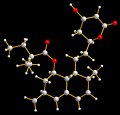Science in the movies was the subject of a a feature I wrote for the now sunk HMSBeagle (on BioMedNet.com), but the world of cinema has moved on apace since then with dozens more feature films that are less science fiction than what my good buddy Carl Djerassi (well, I’ve met him twice!) refers to as science in fiction as well as more impressibley many that are purely science non-fiction.
Here’s just a list of a few currently available on DVD I’d recommend, they’re available on amazon of course but seem to be cheaper at a new site, “DVD ideas”, which has a whole section dedicated to movies about science. Thanks to the guys at DVD Ideas for alerting me to this.
Me & Isaac Newton –
$17.99 on Amazon, $13.99 on DVD ideas – Seven scientists explore the scientific ethos without getting tangled in the technical details of their important work. The film concentrates on how these scientists come up with their ideas and uncovers fascinating contrasts in their biographies and their thinking.
SolarMax – $19.99 on Amazon, $12.99 on DVD ideas – This mind-boggling presentation, originally presented in IMAX theaters, goes to great lengths to explore to far-reaching power and significance of our closest star. From ancient Earth to orbiting spacecraft, explore what the power of the sun means to humankind
Breaking Vegas – $21.99 on Amazon, $16.97 on DVD ideas – Based on Ben Mizrich’s bestselling book, Breaking Las Vegas tells the true story of six college students from MIT – including Mizrich himself – who used their math skills to win millions of dollars at Las Vegas casinos.
Theremin – $12.99 on Amazon, $9.89 on DVD ideas – A documentary about the inventor of one of the first electronic instruments, the eponymous theremin (the sound of which quickly became cliched in science fiction films as the accompaniment to shots of flying saucers as well as providing the eerie ooooooh-eeeeeh-ooooooh sounds in The Beach Boys’ Good Vibrations.
For All Mankind – $35.99 on Amazon, $29.96 on DVD ideas – Shot between December 1968 and November 1972, in the heyday of the space program, FOR ALL MANKIND tells the true story of the 24 men who travelled to the moon as the entire US, and indeed the rest of the world, watched in awe.
If you’re looking for science movies of a more technical or perhaps educational nature, then check out the Sciencebase science movies page. That page has various video links, as well as a few sample science clips.




 Cellulite is of growing concern to a huge number of women and many consider different ways of reducing it including bariatric surgery or a tummy tuck liposuction procedure, diets and other methods, while others really couldn’t care less about the superficial dimpling of their subcutaneous fat. Moreover, it provides yet another example of the medicalisation of a perfectly harmless “condition” as exemplified by the description of “sufferers” as patients.
Cellulite is of growing concern to a huge number of women and many consider different ways of reducing it including bariatric surgery or a tummy tuck liposuction procedure, diets and other methods, while others really couldn’t care less about the superficial dimpling of their subcutaneous fat. Moreover, it provides yet another example of the medicalisation of a perfectly harmless “condition” as exemplified by the description of “sufferers” as patients. 